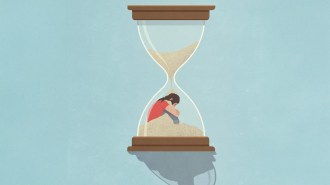In China, coffee shop habits show cultural differences tied to farming
Even among longtime city folk, legacy of rice versus wheat agriculture affects behavior

GROWING CULTURES China’s southern rice farmers (left) and northern wheat farmers (right) have cultivated different cultural approaches to social behavior over thousands of years. These approaches manifest today among southern and northern Chinese city folk patronizing Starbucks, scientists say.
T. Talhelm (L), Richard Ammerman (R)
Deeply ingrained cultural differences in everyday behavior between natives of northern and southern China bubble up while sipping coffee in Starbucks and other cafés.
How close people sit and whether they dodge or move chairs blocking aisles reveals whether their cultural roots go back to rice farming in southern China or wheat farming in northern China, researchers report April 25 in Science Advances.
As many as 9,000 years of neighboring families working together to cultivate rice paddies in southern China has encouraged a lasting focus on others over self, even among that region’s city folk today, say psychologist Thomas Talhelm and colleagues. Social interdependence remains a cultural value of the region, the investigators note.
That dynamic plays out in coffee shops. Middle-class city dwellers in southern China who have never farmed rice often sit with others and show deference by walking around chairs blocking aisles, Talhelm’s group says. In northern cities, people more often sit alone and move offending chairs out of the way. A long history of more individualistic wheat and millet farming in the north has promoted a focus on self over others, the scientists propose.
“Different agricultural legacies have given northern and southern China distinctive cultures of social behavior, even among people who have left farming behind,” says Talhelm, of the University of Chicago’s Booth School of Business.
A lingering sense of interdependence among residents of southern Chinese cities, including Hong Kong, challenges the idea that urban expansion inevitably results in an individualistic, Westernized outlook, he adds.
The new findings make a good case that “vestiges of agricultural practices can persist for some time,” says psychologist Timothy Wilson of the University of Virginia in Charlottesville, who did not participate in the experiments.
Talhelm’s group previously observed similar ways in which thinking styles differ between southern and northern Chinese in lab experiments (SN: 6/14/14, p. 11).

On weekdays, about 30 to 35 percent of people in northern wheat regions sat alone, versus around roughly 25 percent of people in southern rice regions. On weekends, percentages of people sitting alone dipped slightly in each region.
Other factors, including outside temperatures, kind of café (a large chain versus a smaller local one), gender and age, did not explain regional disparities in sitting alone, the team says.
In a second real-world experiment, members of Talhelm’s team stealthily pushed chairs together to block aisles in a total of 29 Starbucks in both regions. The team then observed 678 people navigating these “chair traps.”
People in a self-oriented culture often try to change a situation to their advantage, whereas people in an others-oriented culture typically change themselves to fit the situation, other research suggests. Consistent with that pattern, only about 6 percent of Chinese people in southern rice regions moved Starbucks chairs out of the way rather than squeezing through them, versus about 16 percent of the caffeine crowd in northern wheat regions. Chair moving reached a low of about 2 percent in the southern city of Shanghai.
A majority of people throughout China avoided moving chairs blocking their way, Talhelm acknowledges. But cultural differences in this behavior emerged in a setting where it wouldn’t be expected to show up — an international coffee chain located in large cities where few customers have any farming experience.
Further research needs to examine whether the extent of one’s commitment to, say, a self-orientation observed more frequently in China’s wheat regions, largely explains preferences for sitting alone or moving an inconvenient chair, Talhelm says.







